Practice the AP 9th Class Physical Science Bits with Answers Chapter 2 Laws of Motion on a regular basis so that you can attempt exams with utmost confidence.
AP State Syllabus 9th Class Physical Science Bits 2nd Lesson Laws of Motion with Answers
Question 1.
The tendency of a body to resist change of state is
A) force
B) momentum
C) inertia
D) conservation
Answer:
C) inertia
Question 2.
Law of inertia
A) Newton’s first law of motion
B) Newton’s second law of motion
C) Newton’s third law of motion
D) Law of conservation of mass
Answer:
A) Newton’s first law of motion
![]()
Question 3.
When the net force acting on a body is zero, the body is in
A) motion
B) rest
C) equilibrium
D) none
Answer:
C) equilibrium
Question 4.
Mass of an object is considered as the measure of
A) conservation of mass
B) force
C) momentum
D) inertia
Answer:
D) inertia
Question 5.
A non-zero net force acting on a body disturbs the state of
A) equilibrium
B) motion
C) rest
D) none
Answer:
A) equilibrium
Question 6.
Effect of action of non zero net force on an object is explained by
A) Newton’s first law of motion
B) Newton’s second law of motion
C) Newton’s third law of motion
D) Law of conservation of mass
Answer:
B) Newton’s second law of motion
Question 7.
Product of mass and velocity of an object is known as its
A) equilibrium
B) momentum
C) inertia
D) force
Answer:
B) momentum
Question 8.
Momentum is a …………………. quantity.
A) scalar
B) vector
C) linear
D) constant
Answer:
B) vector
Question 9.
Direction of momentum is in the direction of
A) mass
B) force
C) velocity
D) motion
Answer:
C) velocity
![]()
Question 10.
Acceleration is directly proportional to
A) mass
B) velocity
C) momentum
D) force
Answer:
D) force
Question 11.
Acceleration is inversely proportional to
A) mass
B) velocity
C) momentum
D) force
Answer:
A) mass
Question 12.
Net force is proportional to rate of change of momentum. This is
A) Newton’s first law of motion
B) Newton’s second law of motion
C) Newton’s third law of motion
D) Law of conservation of momentum
Answer:
B) Newton’s second law of motion
Question 13.
1 kg. m/s2 =
A) 1 Dyne
B) 1 Hertz
C) 1 Newton
D) 1 Volt
Answer:
C) 1 Newton
Question 14.
The effect of force exerted by one body on another body is explained by
A) Newton’s first law of motion
B) Newton’s second law of motion
C) Newton’s third law of motion
D) Law of conservation of mass
Answer:
C) Newton’s third law of motion
Question 15.
The product of net force and interaction time is called
A) momentum
B) acceleration
C) conservation
D) impulse
Answer:
D) impulse
Question 16.
Change in momentum depends on
A) magnitude of force
B) time
C) both A & B
D) none
Answer:
C) both A & B
![]()
Question 17.
When a net force acting on a system is zero, then the system is said to be
A) isolated system
B) system of mass
C) system of conservation
D) system of inertia
Answer:
A) isolated system
Question 18.
Newton laws of motion are …………………
A) I law
B) II law
C) III law
D) All of these
Answer:
D) All of these
Question 19.
The tendency of an object to resist a change in their state of rest or uniform motion is …………………..
A) rigidity
B) fluidity
C) inertia
D) compression
Answer:
C) inertia
Question 20.
Newton’s first law of motion is also known as ……………………..
A) Law of friction
B) Law of force
C) Law of inertia
D) Law of momentum
Answer:
C) Law of inertia
Question 21.
When the net acting on a body is zero, the body will be in ………………………
A) motion B) rest
C) acceleration
D) both A & B
Answer:
D) both A & B
Question 22
………………… of an object is considered as the measure of inertia.
A) Volume
B) Pressure
C) Density
D) Mass
Answer:
D) Mass
Question 23.
S.I unit of mass is ………………….
A) kg
B) gram
C) Newton
D) milligram
Answer:
A) kg
![]()
Question 24.
Mass is a property of an object that specifies how much …………….. the object has.
A) rigidity
B) fluidity
C) inertia
D) expansion
Answer:
C) inertia
Question 25.
A non-zero net force acting on a body disturbs the state of ………………….
A) rest
B) motion
C) both
D) neither A nor B
Answer:
C) both
Question 26.
Newton used the word ……………………. to represent momentum.
A) mass in rest
B) mass in stationary
C) mass in motion
D) none of these
Answer:
C) mass in motion
Question 27.
Direction of momentum is direction of …………………
A) speed
B) velocity
C) acceleration
D) force
Answer:
B) velocity
Question 28.
S.I unit of momentum is …………………..
A) kg.m/s2
B) kg-m/s
C) N.Sec
D) Both B & C
Answer:
D) Both B & C
Question 29.
Acceleration increases with increase of …………………….
A) mass
B) pressure
C) volume
D) net force
Answer:
D) net force
Question 30.
Acceleration decreases with increases of …………………..
A) mass
B) volume
C) density
D) pressure
Answer:
A) mass
![]()
Question 31.
The unit of force is ……………
A) Newton
B) N.S
C) N/s
D) N.m
Answer:
A) Newton
Question 32.
Force F = ……………………
A) ma
B) m(\(\frac{\mathrm{v}-\mathrm{u}}{\mathrm{t}}\))
C) \(\frac{\mathrm{mv}}{\mathrm{t}}\)
D) Both A & B
Answer:
D) Both A & B
Question 33.
When an object exerts a force on other object, the result will be explained by ……………………… of motion.
A) Newton’s first law
B) Newton’s second law
C) Newton’s third law
D) None of these
Answer:
C) Newton’s third law
Question 34.
In Newton’s third law of motion, the two opposing forces are known as …………………
A) reactant, product pair
B) action, reaction pair
C) force, retardation pair
D) none of these
Answer:
B) action, reaction pair
Question 35.
When a net force acting on a system is zero, then that system is called …………………….
A) isothermal
B) adiabatic
C) isolated
D) isochoric
Answer:
C) isolated
Question 36.
The product of net force and interaction time is called …………………
A) momentum
B) force
C) acceleration
D) impulse
Answer:
D) impulse
Question 37.
The change in momentum that an object experiences during an interaction is equivalent to ………………….
A) momentum
B) couple
C) impulse
D) torque
Answer:
C) impulse
![]()
Question 38.
Change of momentum is related to ………………….
A) First law of motion
B) Second law of motion
C) Third law of motion
D) None of these
Answer:
B) Second law of motion
Question 39.
The equation for law of conservation momentum is …………………
A) m1u1 – m2u2 = m1v1 – m2v2
B) m2u2 – m1u1 = m2v2 – m1v1
C) m1u1 + m2u2 = m1v1 + m2v2
D) \(\frac{m_{1} u_{1}}{m_{1} u_{2}}+\frac{m_{2} v_{2}}{m_{1} v_{1}}\) = 0
Answer:
C) m1u1 + m2u2 = m1v1 + m2v2
Question 40.
F net Δt is formula of …………………
A) acceleration
B) force
C) impulse
D) momentum
Answer:
C) impulse
Question 41.
Momentum is given by ………………
A) \(\frac{\Delta \mathrm{s}}{\Delta \mathrm{t}}\)
B) \(\frac{\Delta \mathrm{v}}{\Delta \mathrm{t}}\)
C) mv
D) ma
Answer:
C) mv
Question 42.
\(\frac{\Delta \mathrm{v}}{\Delta \mathrm{t}}\)is ……………….
A) force
B) momentum
C) displacement
D) acceleration
Answer:
D) acceleration
Question 43.
Effect of action of no net force acting on an object
A) First law of motion
B) Second law of motion
C) Third law of motion
D) None of these
Answer:
A) First law of motion
Question 44.
Effect of action of non-zero net force acting on an object
A) First law of motion
B) Second law of motion
C) Third law of motion
D) None of these
Answer:
B) Second law of motion
![]()
Question 45.
Assertion (A) : When a ball throw on the ground, it come to rest.
Reason (R) : Every object will remain rest when no net force acts on it.
A) A and R are true, R is the correct explanation of A.
B) A and R are true, R is not the correct explanation of A.
C) A is true and R is false.
D) A is false and R is true.
Answer:
B) A and R are true, R is not the correct explanation of A.
Question 46.
Which of the following is wrong ?
a) Static inertia : The body at rest always tries to stay at the same rest, until some force act on it.
b) Dynamic inertia : The body which is in motion always tries to come to ? rest until some force act on it. ?
A) a
B) b
C) a and b
D) None
Answer:
B) b
Question 47.
If there is no friction a moving ball
A) comes to rest
B) moves in uniform motion
C) moves with increasing speed
D) disappears
Answer:
B) moves in uniform motion
Question 48.
We can push a bicycle easily, then a car because,
A) mass of the bicycle > mass of the car
B) mass of the car > mass of the bicycle
C) momentum of the car > momentum of the bicycle
D) momentum of the bicycle > momentum of the car
Answer:
B) mass of the car > mass of the bicycle
Question 49.
A body is disturbed its state of equilibrium. Guess the reason.
A) A non – zero force acted on it
B) Zero net force acted on it
C) Either A or B
D) Neither A nor B
Answer:
A) A non – zero force acted on it
Question 50.
Force : ma :: momentum :…………………….
A) m.f
B) mg
C) mv
D) 1/2mv2
Answer:
C) mv
Question 51.
When we drop an egg on a soft pillow,
A) it do not break due to low impulse
B) it will break due to high impulse
C) A or B
D) it do not break due to high impulse
Answer:
A) it do not break due to low impulse
![]()
Question 52.
What will happen, if a non-net force acts on a body in a uniform motion ?
A) It accelerates
B) It decelerates
C) A or B
D) A and B
Answer:
C) A or B
Question 53.
Formula a = b × c, says that the net force produces acceleration in a body in the direction of force, then the physical quantity of a, b and c are (respectively)
A) Fnet, mass, velocity
B) Fnet, mass, acceleration
C) Acceleration, mass, friction
D) mass, Fnet, gravitation
Answer:
B) Fnet, mass, acceleration
Question 54.
Force : \(\frac{\mathbf{k g} \cdot \mathbf{m}}{\mathbf{s}^{2}}\) :: ……… . : \(\frac{\mathbf{k g}-\mathbf{m}}{\mathbf{s}}\)
A) friction
B) acceleration
C) momentum
D) none
Answer:
C) momentum
Question 55.
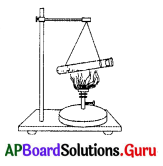
What will happen in this experiment?
A) Cork cap and test tube moves in the same direction.
B) Cork cap and test tube moves in the opposite direction.
C) Tension in string decreases.
D) The cork cap drops in the test tube.
Answer:
B) Cork cap and test tube moves in the opposite direction.
Question 56.
If a fly colloids with the wind sheild of a fast moving bus, then
a) the impact forces experienced by the fly and bus are same.
b) the acceleration experienced by the fly and bus are same.
A) ‘a’ only
B) ‘b’ only
C) both ‘a’ and b’
D) neither ‘a’ nor ‘b’
Answer:
A) ‘a’ only
Question 57.
If a bird dashes a flying aeroplane,
A) bird will hurt seriously
B) aeroplane will damage
C) aeroplane will stop
D) A and B
Answer:
D) A and B
![]()
Question 58.
When a marble rolls down a slope, it picks up speed due to ……………….
A) normal force
B) frictional force
C) tension
D) force of gravity
Answer:
D) force of gravity
Question 59.
When an object rolls up an inclined plane its speed ……………………
A)increases
B) decreases
C) no change
D) none of these
Answer:
B) decreases
Question 60.
Materials required to show static friction in your lab are
A) bottle, paper, scale
B) glass, wooden planck, stand
C) bottle, paper, pen cap
D) test tube, cork, water
Answer:
C) bottle, paper, pen cap
Question 61.
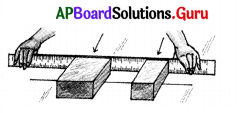
Conclusion of the given experiment is
A) inertia of an object depends upon its mass.
B) inertia of an object depends upon its shape.
C) there is no relation between mass and inertia.
D) none of the above.
Answer:
A) inertia of an object depends upon its mass.
Question 62.

This experiment is used to prove
A) Newton’s first law of motion
B) Newton’s second law of motion
C) Newton’s third law of motion
D) Newton’s Gravitational theory
Answer:
C) Newton’s third law of motion
Question 63.
From the above given figure, your observation is, if we pull one of the spring balances, the reading in other spring balance
A) increases
B) decreases
C) no change
D) we cannot say
Answer:
A) increases
Question 64.
To prove Newton’s third law of motions the required apparatus are
A) two weights
B) two test tubes
C) two scales
D) two spring balances
Answer:
D) two spring balances
![]()
Question 65.
“The natural state of an earthly object is to be at rest.” This idea was concluded by
A) Galileo
B) Aristotle
C) Newton
D) Einstein
Answer:
B) Aristotle
Question 66.
The statement: “An object in motion will remain in same motion as long as no external force is applied on it” is given by
A) Galileo
B) Aristotle
C) Newton
D) Einstein
Answer:
A) Galileo
Question 67.
Laws of motion were proposed by
A) Galileo
B) Aristotle
C) Newton
D) Einstein
Answer:
C) Newton
Question 68.
The connection between the force and change in motion was explained by ………………..
A) Kepler’s laws
B) Newton’s laws of motion
C) Faraday’s laws of motion
D) None of these
Answer:
B) Newton’s laws of motion
Question 69.
For a body Fnet = 0
From the given data the velocity of the body is
A) zero
B) constant
C) A or B
D)A and B
Answer:
C) A or B
Question 70.
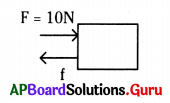
The body is moving is steadily. Then the friction is
A) zero
B) 10 N
C) 10 × 9.8 N
D) none
Answer:
B) 10 N
Question 71.
Tension in the string of an atwood machine is \(\frac{2 \mathrm{~m}_{1} \mathrm{~m}_{2} \mathrm{~g}}{\mathrm{~m}_{1}+\mathrm{m}_{2}}\) and m1 = m2
From the given data tension in string equals to
A) weight
B) mass
C) gravitation
D) weight/2
Answer:
A) weight
![]()
Question 72.
FAB = – FBA From the data the following statement is false.
A) Negative sign indicates less force
B) FAB is a force of a action
C) No single isolated force exists
D) It is an application of Newton’s third law
Answer:
A) Negative sign indicates less force
Question 73.
Below figure was best example for

A) Newtons first law of motion
B) Newtons second law of motion
C) Newtons third law of motion
D) None of these
Answer:
C) Newtons third law of motion
Question 74.
Name the used system in the given figure.

A) At wood machine
B) Chain system
C) Momentum
D) None
Answer:
A) At wood machine
Question 75.
Use of above system was
A) To prove the Newtons laws of motion
B) To find acceleration
C) Both A and B
D) None of the above
Answer:
A) To prove the Newtons laws of motion
Question 76.
The free body diagram that shows forces acting on a book on a table is
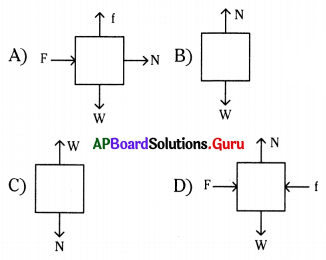
Answer:

Question 77.
A body of mass’m’ is kept on a table and it is pushed in the horizontal direction with force of 10N continuously. Free body diagram of the body is
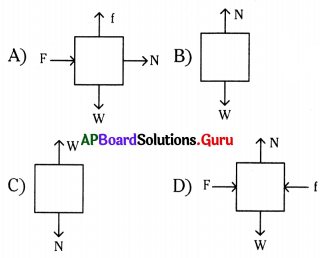
Answer:
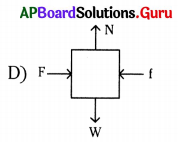
Question 78.
Free body diagram of the given situation. “A monkey is hanging branch of a tree.”

Answer:
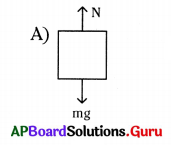
![]()
Question 79.
The velocity of a small object that has separated from a rocket moving in free space with velocity of 11 km/s is
A) 0 km/s
B) 11 km/s
C) 11 × 9.8 km/s
D) None
Answer:
B) 11 km/s
Question 80.
You are travelling in a bus with 40 km/hr speed. Then your speed related to the observer standing out side of the bus is
A) zero
B) 40 km/hr
C) 40 × 9.8 km/hr
D) none
Answer:
B) 40 km/hr
Question 81.
A heavy truck and bicycle hit a wall, with same velocity. More damage to the wall expected from
A) heavy truck
B) bicycle
C) both
D) nothing will happen
Answer:
A) heavy truck
Question 82.
If a badminton ball and a cricket ball hit you with same speed, which one hurts you more and why ?
A) Badminton ball – more momentum
B) Cricket ball – less momentum
C) Badminton ball – less momentum
D) Cricket ball – more momentum
Answer:
D) Cricket ball – more momentum
Question 83.
The great phrase “mass in motion” instead of momentum is used by
A) Galelio
B) Aristotle
C) Newton
D) Einstein
Answer:
C) Newton
Question 84.
m1 = 6.2 kg, m2 = 3.6 kg then tension in the string is

A) 44. 64 N
B) 63.24 N
C) 22.32 N
D) None
Answer:
A) 44. 64 N
Question 85.
Which of the following is not an application of Newton’s third law of motion ?
A) Flying of a bird
B) Swimming of a fish
C) Walking on a road
D) None
Answer:
D) None
![]()
Question 86.
The force exerted by the earth on a ball is 8N. The force on the earth by the ball is
A) 8 × 9.8 N
B) 8N
C) 4N
D) Zero N
Answer:
B) 8N
Question 87.
It is difficult for a fire fighter to hold a hose (pipe) that ejects large amount of water at high speed.
The Law involved in it is
A) Newton’s first law of motion
B) Newton’s 2nd law of motion
C) Newton’s 3rd law of motion
D) Newton’s 4th law of motion
Answer:
C) Newton’s 3rd law of motion
Question 88.
The fielder pulls back his hands while catching a fast moving cricket ball. It gives ………………
a) less stopping distance
b) more stopping distance
c) less time to stop
d) more time to stop
A) a, c
B) b, d
C) a, d
D) b, d
Answer:
B) b, d
Question 89.
The application of “impulse of force acts on the driver for longer time when accident occurs”.
A) Breaks of the vehicles
B) Air bags inside the vehicles
C) Breaking of the glass windows
D) Power stearing of the vehicle
Answer:
B) Air bags inside the vehicles
Question 90.
Safety net to save a person who jumps from a height provides
A) low impulse
B) high impulse
C) low inertia
D) high inertia
Answer:
A) low impulse
Question 91.
If you bite by a stick on your palm, how do you escape from a larger impulse on your hand ?
A) By pulling down your palm along the direction of the stick
B) By raising up your palm opposite to the direction of the stick
C) By giving no moment to your palm
D) By catch the stick with palm
Answer:
A) By pulling down your palm along the direction of the stick
Question 92.
The following is not an application of the formule ΔP = FnetΔT (Here more Fnet)
A) egg drops on a concrete floor
B) hit by a bicycle
C) pulling hands back while catching a ball
D) jumping on a cement road
Answer:
C) pulling hands back while catching a ball
![]()
Question 93.
The following is not an application of the formula ΔP = Fnet ΔT
(Here more ΔT
A) egg dropping on a cushion
B) pulling hands back while catching a ball
C) opening of air balloons while hitting of a wall by a car
D) hitting of a ball to the body
Answer:
D) hitting of a ball to the body
Question 94.
Principle involved in the parachutes
A) Longer time to hit the land-low impulse
B) Longer time to hit the land-high impulse
C) Shorter time to hit the land-low impulse
D) Shorter time to hit the land-high impulse
Answer:
A) Longer time to hit the land-low impulse
Question 95.
When a carpet is beaten with a stick dust comes out due to
A) static inertia of dust
B) static inertia of carpet
C) dynamic inertia of dust
D) none
Answer:
A) static inertia of dust
Question 96.
Luggage kept on the roof of a bus is tied with a rope, because it fall down due to
A) static inertia of the luggage
B) static inertia of the bus
C) both A and B
D) dynamic inertia of the luggage
Answer:
A) static inertia of the luggage
Question 97.
Bowler In cricket runs in from a long distance before he bowls to provide
A) static inertia to the ball
B) dynamic inertia to the ball
C) both A and B
D) none
Answer:
B) dynamic inertia to the ball
Question 98.
Which of the following has more inertia ?
A) 8 kg stone
B) 25 kg stone
C) 80 kg stone
D) All are equal
Answer:
C) 80 kg stone
![]()
Question 99.
The momentum of a 6.0 kg bowling ball with a velocity of 3 m/s
A) 6 kg m/s2
B) 18 kg m/s2
C) 2 kg m/s2
D) 180 kg m/s2
Answer:
B) 18 kg m/s2
Question 100.

What is the net force?
A) 350 N
B) 250 N
C) 50 N
D) None
Answer:
B) 250 N
Question 101.
A passenger in moving train tosses a coin which falls behind him. It means that the motion of the train is
A) accelerated
B) uniform
C) retarded
D) circular motion
Answer:
A) accelerated
Question 102.
If a car is travelling westwards with a constant speed of 20 m/s. The resultant force acting on it is
A) 20 m/s
B) 20 × 9.8 m/s
C) zero
D) 10 m/s
Answer:
C) zero
Question 103.
A man of mass 30 kg uses a rope to climb which bears only 450 N. The maximum acceleration with which he can climb safely is
A) 45 m/s2
B) 30 m/s2
C) zero
D) 15 m/s2
Answer:
D) 15 m/s2
Question 104.
A vehicle has a mass of 1500 kg. What must be the force between the vehicle and the road if the vehicle is to be stopped with a negative acceleration of 1.7 m/s2 ?
A) 2500 N in a direction opposite to that of the vehicle.
B) 2500 N in a direction of the vehicle.
C) 2550 N in a direction opposite to that of the vehicle.
D) 2550 N in a direction of the vehicle.
Answer:
C) 2550 N in a direction opposite to that of the vehicle.
Question 105.
A truck is moving under a hopper with a constant speed of 20 m/s. Sand falls on the truck at a rate of 20 kg/s. The force acting on the truck due to falling of sand is
A) 40 N opposite to the motion of the truck
B) 400 N opposite to the motion of the truck
C) 40 N along the motion of the truck
D) 400 N along the motion of the truck
Answer:
B) 400 N opposite to the motion of the truck
![]()
Question 106.
A ball of mass 1 kg moves perpendicularly to a bat with a speed of 5 m/s. And the bat of 10 kg moves opposite to the ball with 2 m/s. After hitting ball moved with 15 m/s. What is the speed of bat after hit ?
A) 1 m/s
B) 2 m/s
C) 3 m/s
D) zero
Answer:
A) 1 m/s
Question 107.
Identify the correct statement regarding Aristotle’s belief.
A) Any moving body naturally comes to rest.
B) Any body which is at rest naturally starts moving.
C) A body continues its state of rest or uniform motion unless a net force acts on it.
D) Any moving body continues in the state only until some external force acts on it.
Answer:
A) Any moving body naturally comes to rest.
Question 108.
Match the physical quantities given in Set – A with proper units in Set – B.
| Set – A | Set – B |
| P. Force | x. kg ms2 |
| Q. Momentum | y. kg ms-2 |
| R. Impulse | z. kg ms-1 |
A) P – x, Q – z, R – y
B) P – y, Q – z, R – x
C) P – z, Q – x, R – y
D) P – x, Q – y, R – z
Answer:
B) P – y, Q – z, R – x
Question 109.
Pavithra : Action reaction pair in Newton’s third law always represents forces acting on two bodies simultaneously.
Teja : Newton’s first and second laws of motion apply to a single body.
A) Both Pavithra and Teja are incorrect.
B) Pavithra is correct, Teja is incorrect.
C) Pavithra is incorrect, Teja is correct.
D) Both Pavithra and Teja are correct.
Answer:
D) Both Pavithra and Teja are correct.
Question 110.
When we drop an egg on the concrete floor it will break because
A) smaller force acts on the egg for shorter time.
B) smaller force acts on the egg for longer time.
C) large force acts on the egg for shorter time.
D) large force acts on the egg for longer time.
Answer:
C) large force acts on the egg for shorter time.
Question 111.
When 2.5 kg weight of hero’s hand hits the villain of 80 kg who is at rest, the villain moves with 12.5 ms-1 and hits the transformer near by. What will be the speed of hero’s hand compared to the bullet fired from the gun ? (Speed of bullet fired from the gun is 370 ms-1)
A) Less than bullet speed
B) Very very less than bullet speed
C) 0
D) Greater than bullet speed
Answer:
D) Greater than bullet speed
Question 112.
Assertion (A) : Pace bowler Bumrah runs in from a long distance before he bowls.
Reason (R) : To acquire dynamic inertia.
A) Both (A), (R) are correct, (R) is correct explanation of (A).
B) (A) is correct, (R) is incorrect.
C) (A) is incorrect, (R) is correct.
D) Both (A), (R) are correct, (R) is not correct explanation of (A).
Answer:
B) (A) is correct, (R) is incorrect.
Question 113.
Take a block of ice and place it on a smooth surface, push the block with some net force. Now increase the net force and push it again. The outcome of the experiment is
A) Smaller the net force larger the acceleration
B) Smaller the net force smaller the acceleration
C) Larger the net force larger the acceleration
D) Larger the net force smaller the acceleration
Answer:
C) Larger the net force larger the acceleration
Question 114.
Make a stack of carrom coins on the carrom board. Give a sharp hit at the bottom of the stack with the striker. The law which represent the above experiment is
A) Newton’s second law of motion
B) Newton’s third law of motion
C) Newton’s fourth law of motion
D) Newton’s first law of motion
Answer:
D) Newton’s first law of motion
Question 115.
Read the passage given below :
Inertia is a property of matter that resists changes in its state of motion or rest. It depends on the mass of the object. Arrange the following animals in the increasing order of inertia :
a. Elephant
b. Lion
e. Dog
d. Rat
A) d, c, b, a
B) b, a, c, d
C) c, d, a, b
D) a, b, c, d
Answer:
A) d, c, b, a
Question 116.

Five pendulums are suspended as shown in figure, il first pendulum is pulled a side and released you will see that pendulum 5 will move a side, if you do it with first two, last two will move and so on.
What is the principle involved in the above activity?
A) Law of conservation of energy
B) Law of conservation of momentum
C) Law of conservation of charge
D) Law of conservation of mass
Answer:
B) Law of conservation of momentum
Question 117.
Which of the following represent correct diagram of atwood machine?

Answer:
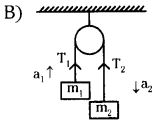
Question 118.
A boy of mass 30 kg uses a rope to climb which bears nearly 600 N. What is the maximum acceleration with which he can climb safely ?
A) 0.05 ms-2
B) 20 ms-2
C) 0
D) 18000 ms-2
Answer:
B) 20 ms-2
Question 119.
A ball of mass ‘m’ moves perpendicularly to a wall with a speed ‘v’ strikes it and rebounds with the same speed is the change in momentum.
A) \(\frac{1}{2}\) mv
B) 2 mv
C) mv
D) 0
Answer:
D) 0
Question 120.
The main apparatus in atwood machine
A) Pulley
B) Scale (graduated in centimeters)
C) Barometer
D) Spring balance
Answer:
A) Pulley
Question 121.
Which of the following states the law of constant proportions ?
A) Matter is neither created nor destroyed during a chemicaPreaction.
B) A given chemical substance always contains the same elements combined in fixed proportion.
C) Atoms of different elements have different masses and chemical properties.
D) Compounds are formed when atoms of different elements combine in whole number ratios.
Answer:
D) Compounds are formed when atoms of different elements combine in whole number ratios.
Question 122.
Which property of an object determines how much inertia it has ?
A) Acceleration of the object
B) Velocity of the object
C) Mass of the object
D) Shape of the object
Answer:
C) Mass of the object
Question 123.
A force of IN acts on a body of mass 5kg. The body covers 100 cm in 2 seconds moving along a straight line. The initial velocity is
A) 200 cm/sec
B) 102 cm/sec
C) 0.5 cm/sec
D) 120 cm/sec
Answer:
D) 120 cm/sec
Question 124.
Take two bricks of different masses and place them on a straight line on the floor. Push both with the same force at the same time with a wooden scale. Which of the following can be observed ?
A) The brick with greater mass moves the same distance as the brick with lesser mass.
B) The brick with greater mass moves more than the brick with lesser mass.
C) The brick with greater mass moves less than the movement of the brick with lesser mass.
D) The brick with greater mass will move and the brick with lesser mass will not move at all.
Answer:
C) The brick with greater mass moves less than the movement of the brick with lesser mass.
Question 125.
When an object exerts a force on the other object, the second object also exerts a force on the first one which is equal in magnitude but opposite in direction.
Which of the following is BEST explained by the above ?
A) Newton’s first law of motion
B) Newton’s second law of motion
C) Newton’s third law of motion
D) Law of conservation of momentum
Answer:
C) Newton’s third law of motion
Question 126.
NewtonSec is the unit for
A) Momentum
B) Inertia
C) Impulse
D) Force
Answer:
A) Momentum
Question 127.
A suitcase kept in a moving bus moves forward when the bus.
A) Comes to rest
B) Moves forward
C) Takes turn
D) At rest
Answer:
A) Comes to rest
Question 128.
Two people push a car for 2s with a combined net force of 250 N. The impulse providedjo the car is
A) 500 NS
B) 12\(\frac{\mathrm{N}}{\mathrm{S}}\)
C) 0
D) 250 N
Answer:
A) 500 NS
Question 129.
In the paper ring activity of our text book we observe the result of
A) Force
B) Inertia
C) Velocity
D) Acceleration
Answer:
B) Inertia
Question 130.
Which of the following law is illustrated by Balloon rocket activity :
A) Newton’s first law
B) Newton’s Second law
C) Newton’s Third law
D) Newton’s Law of Gravity
Answer:
C) Newton’s Third law
Question 131.
S.I. Unit of Force is
i. kgms-2
ii. \(\frac{\mathrm{kg}}{\mathrm{ms}^{-2}}\)
iii. newton
A) iii only
B) ii and iii
C) i and iii
D) i, ii and iii
Answer:
C) i and iii
Question 132.
Safe way to catch the fast moving cricket ball is, while catching
A) Keep the hands steady
B) Push the hands towards the ball
C) Pull the hands back
D) A and B
Answer:
C) Pull the hands back